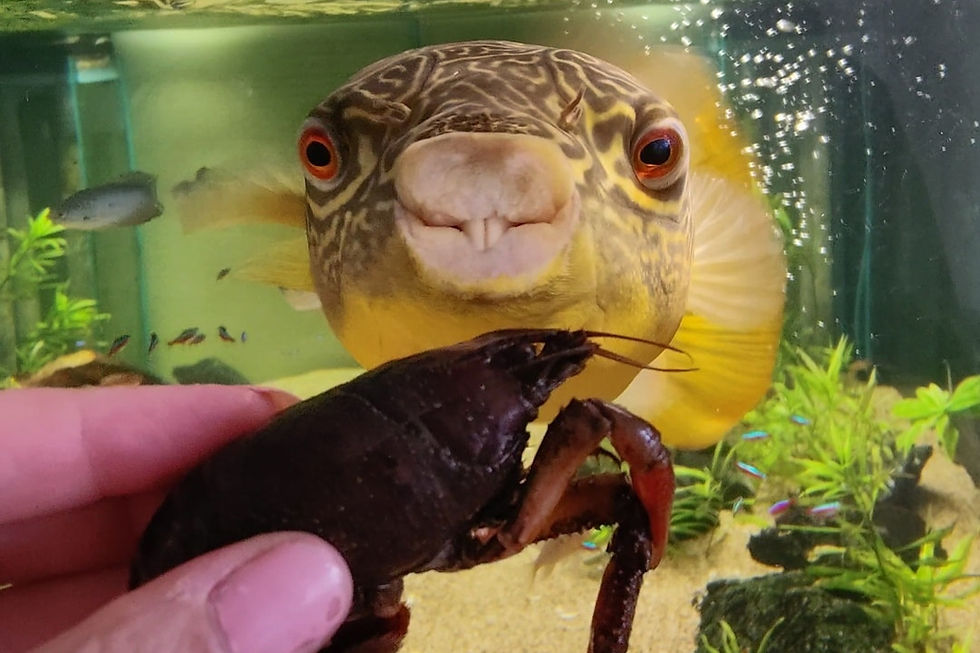The Pufferfish Keeper's Guide to Common Names
- Macauley Sykes

- Sep 2
- 3 min read
If you’re a member of Pufferfish Enthusiasts Worldwide (or any of our sister groups), you’ve probably noticed that we encourage the use of scientific names (binomials) rather than common or vernacular names when discussing pufferfish and their care.
Many people ask us why this is, especially since scientific names can feel complicated or difficult to remember at first. The short answer is: it actually makes things easier. Using scientific names removes any doubt about which species is being discussed and helps ensure that the information being shared (particularly about care requirements) is accurate for that exact species.
Our aim with this article is to show how valuable scientific names can be for hobbyists.
By the end, we hope you’ll see that learning them isn’t just useful, it can make your fishkeeping journey smoother and more rewarding.
Let’s begin by looking at the differences between a common name and a scientific name.
What is a common name?
Common names are the everyday words people use to describe a fish — “Green Spotted Puffer,” “Figure Eight Puffer,” or “Dogface Puffer.” They are usually easier to remember and are often descriptive of appearance, colour, or behaviour. However, they are not standardised. The same species can be called many different things in different countries, or the same name might be applied to several different species.
What is a scientific name?
Scientific names (binomials) follow the system of Latinised naming, consisting of a genus and species (e.g., Carinotetraodon travancoricus). They are globally standardised, so a scientist in Brazil and a hobbyist in Germany are talking about the same fish when they use them. This avoids confusion and ensures the correct information can be shared.
The problems with common names
Overlaps (one name, many species). Common names often act like umbrellas. “Green spotted puffer” is used for more than one Dichotomyctere species, which don’t all share the same adult salinity needs. Likewise, “Red Eye Puffer” can refer to a whole cluster of small Southeast Asian species (at least nine in the trade), each with different sizes, temperaments, and habitat preferences. So when someone asks, “What should I feed my Red Eye Puffer?”, we can’t give a reliable answer until we know which species they actually have.
Regional differences (same name, different fish). Shops and importers use the names they know, or the ones that sell. A “Porcupine Puffer” in one store may be a Diodon holocanthus, while in another it’s a Diodon hystrix. The fish may look broadly similar at a glance, but one grows almost double the length.
Life stage look-alikes. Juveniles often wear different colours or patterns from adults. A youngster sold under a catchy label can grow into something quite different from what the buyer expected, sometimes much larger and sometimes far more aggressive.
Marketing names and “box names.” Exporters, wholesalers, and retailers sometimes invent or inherit trade names (“dragon,” “avocado,” "Amazon," “arrowhead,” or “golden”) that aren’t tied to a single species. These names stick because they’re memorable, but they’re not diagnostic.
Translation and spelling drift. Across languages and forums, you’ll see “Fahaka,” “Fahakka,” “Fahaca”; “Mbu,” “Mubu,” “Imbu.” These variations make search results noisy and can bury species-specific guidance.
At Pufferfish Enthusiasts Worldwide, we’ll always do our best to model good practice by pairing common names with scientific names. It keeps everyone on the same page and makes the advice that follows far more accurate and useful.
Green Spotted Puffer (Dichotomyctere nigroviridis)
If you’re unsure which species you have, share photos and details in one of our groups, and we’ll help you pin down the correct binomial so the care guidance always fits the fish in front of you.



Comments